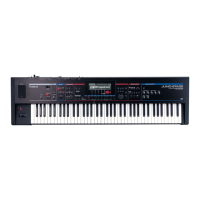42
Chapter 1. Overview
Temporary Memory
Temporary Area
This is the area that holds the data for the patch or performance that
you’ve selected using the panel buttons.
When you play the JUNO-STAGE, sound is produced based on data
in the temporary area. When you edit a patch or performance, you
do not directly modify the data in memory; rather, you call up the data
into the temporary area, and edit it there.
Settings in the temporary area will be lost when the power is turned
off or when you select another patch/performance. To keep the
settings you have modified, you must write them into user memory.
Rewritable Memory
User Memory
User memory is where you normally store the data you need.
To store a performance, execute Performance Write (p. 133). To store
a patch, execute Patch Write (p. 97). To store a Rhythm Set, execute
Rhythm Set Write (p. 123).
Arpeggio, chord memory, and rhythm pattern data you create is also
stored in user memory (p. 63, p. 65, p. 77).
System Memory
System memory stores system parameter settings that determine how
the JUNO-STAGE functions.
To store system parameters, execute System Write (p. 145).
USB Memory
The following settings can be backed up together to USB memory.
• User patches (rhythm sets)
• User performances
• Favorites
• User arpeggios
• User chord memories
• User rhythm patterns
• User rhythm groups
• MIDI controller mode settings
• The patch first selected in Piano mode
• System settings
Non-Rewritable Memory
Preset Memory
Data in Preset memory cannot be rewritten. However, you can call up
settings from preset memory into the temporary area, modify them and
then store the modified data in rewritable memory.
Wave Expansion Boards (optional: SRX Series)
The JUNO-STAGE can be equipped with up to two Wave Expansion
Boards (optional: SRX Series). Wave Expansion Boards contain Wave
data, as well as patches and rhythm sets that use this Wave data,
which can be called directly into the temporary area and played.
The JUNO-STAGE’s sound generator can operate in one of two
modes: Patch mode or Performance mode (p. 38). You can switch
between these two modes as appropriate for your situation.
Patch Mode
PATCH PLAY Screen
Press [PATCH] to access this screen.
In this screen you can select the patch or rhythm set that you’ll play
from the keyboard.
fig.PatchPlay_70
Performance Mode
In Performance mode you can perform using multiple sounds (patches
and/or rhythm sets).
PERFORM PLAY Screen
Press [PERFORM] to access this screen.
This screen lets you select a performance.
Here you can also make detailed settings for the performance.
fig.PfmLayer_70
PART SELECT Screen
Press [PART SELECT] to access this screen.
For each part, this screen shows the patch or rhythm set that is
selected for that part.
If you’re playing two patches as a layer (Dual: p. 51) or two patches
split between the left and right regions of the keyboard (Split: p. 51),
both patches will be shown in a single screen.
Basic Operation of the JUNO-STAGE
Switching the Sound Generator Mode
JUNO-STAGE_e.book 42 ページ 2008年10月17日 金曜日 午後12時27分

